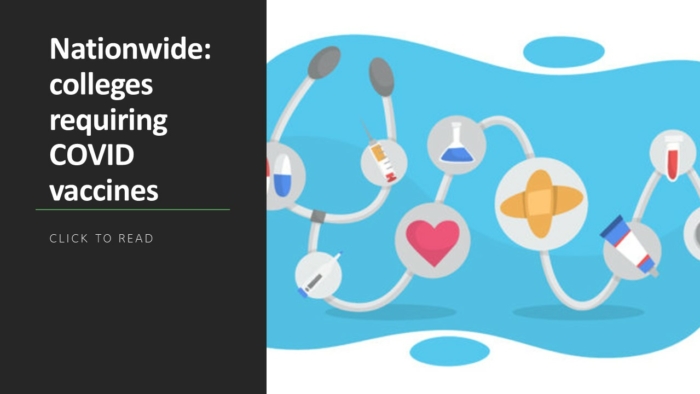Positivity rates and hospitalizations have been the two key metrics tracked by higher education leaders throughout the COVID-19 pandemic. When they go up, colleges and universities are pressed to make a choice: adjust protocols or stay status quo.
More than two years into the world health crisis, however, there is still a lot of uncertainty over whether and when pivots should be made. Some colleges have been adjusting on the fly only as case counts rise, while some have been hellbent on fighting through in this new normal, citing that the endemic phase of the virus is here. But is it?
In the past two weeks, positive cases have risen more than 50% in seven states and the District of Columbia, largely driven by the now-dominant BA.2 variant. Most notable is the shift in hospitalizations, which had tumbled for several months. Three New England states – Connecticut, Vermont and New Hampshire – have seen a more than 20% increase, while Maine is also up 10%. A pattern that emerged in the UK, where cases from this Omicron spinoff also led to boost in hospitalizations, could be playing out in the northeastern U.S. So, how well will institutions and local officials be able to respond if numbers keep rising?
“What we saw with omicron was, if we get hit hard fast, you can’t build the apparatus overnight,” said Manisha Juthani, Connecticut Public Health Commissioner, referring to the state’s ability to increase testing again. “It just cannot happen.”
The same can be said for higher education, though institutions have been remarkably savvy at pivoting when they’ve had to – increasing testing, offering up daily updates on dashboards, providing isolation housing (some in their own rooms) and stepping up mask mandates. Those that haven’t removed protocols will have an edge during this go-round of COVID. Those that have completely abandoned protocols likely would be in scramble mode.
“It highlights the importance of having a well-designed plan with a dashboard or criteria to use as pivot points,” says Gerri Taylor, Co-Chair of the American College Health Association’s COVID-19 Task Force. “Administrators should be preparing their communities for the inevitability of having to increase or decrease mitigation based on changes in the direction of the variants. COVID-19 has continued to be a very changeable virus – it is very difficult to say that masks will not be needed again. It is likely they will be needed.”
More from UB: With COVID-19 cases up again, masks return at two DC universities
For the institutions that have announced plans to be more open, the reality is, they may not want to. Hearing reports that this Omicron spinoff is less serious than Delta and that their student populations might be immune from major effects (although there is still much to be learned about long COVID), those in endemic mode might not want to bring back protocols. If they don’t, does that put individuals with comorbidities or their regions at risk?
“There is fatigue as it relates to mitigation strategies like masking. Asking community members to return to a practice that was just suspended will likely meet with some resistance,” says ACHA Task Force Co-Chair Anita Barkin. “The current variant BA.2, while highly transmissible, does not appear to have the virulence of a strain like Delta. This decreased virulence may give people a false sense of security which will dampen enthusiasm for mitigation strategies like masking. Depending on local conditions, campus leadership should consider a phased approach where mask requirements are reserved for higher risk situations (indoor, closer seating, greater number of attendees).”
The two task force members are in agreement that college leaders should remain vigilant and continue to impart messaging that lets students know that pivots can happen any time.
“Expectations are key,” Taylor says. “Marketing must be done to inform the community that this is not completely over and that there will be ups and downs and to protect ourselves and each other. We will need to be nimble and switch gears when needed.”
If they have to install mandates again, as Johns Hopkins University and Georgetown University boldly did with mask requirements on Thursday because of spikes in cases, what should leaders be saying to students, faculty and staff?
“Messaging on reinstatement should clearly state the rationale for the pivot back to masking,” Barkin says. “That includes prevalence of illness on campus and in the surrounding community, the importance of keeping the number of cases low in order to continue to provide a robust campus experience, positive statements about the community members’ contribution to the success of strategies in the past and the plan for providing regular updates on the situation to the campus community.”
Which numbers should be driving decisions?
“Case prevalence in the surrounding community is probably the bigger factor,” Barkin says. “Hospitalizations could become a larger factor if the health care system is under a high level of stress and at full capacity.”








